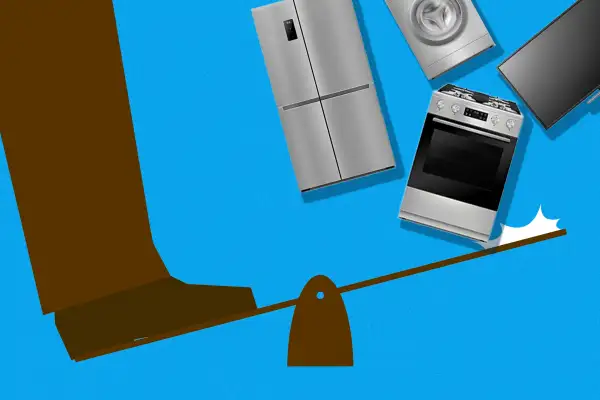Trump's Tariffs Could Start in February. Here's How to Prepare

President Donald Trump is signaling broad tariffs are coming soon, especially on goods coming from Canada, China and Mexico.
As of Tuesday, Trump threatened tariffs between 10% and 100% on Chinese goods and 25% on Canadian and Mexican goods. During a press conference at the White House, he suggested they could be implemented as soon as Feb. 1.
In addition to generating federal revenue, Trump says his tariffs will incentivize manufacturing here at home and retaliate against countries he sees as taking advantage of the U.S.
"Other countries are big abusers too," Trump said. "It's not just China. The European Union is very, very bad to us."
Meanwhile, experts are warning that tariffs — which in this case are trade taxes that will need to be paid by U.S. businesses — could drastically increase the price of everyday products for Americans.
About 25% of the goods Americans buy come from other countries, and recent studies found that consumer tech (like laptops, TVs, smartphones), clothing, furniture, toys and more could spike in price if tariffs are enacted, resulting in a collective loss of about $150 billion of buying power for Americans.
The timing isn't great, either: The proposals come just as the country is shaking off one of the highest bouts of inflation since World War II.
“Right now, there’s just a lot of uncertainty” as to which nations will face the tariffs and how high those rates will be, Jonathan Gold, the vice president of supply chain and customs policy with the National Retail Federation, told Money in December. The industry trade group represents retail giants like Amazon, Target and Walmart.
But analysts agree that whatever the ultimate tariffs may be, prices for affected products will go up. And that means it may behoove you to take action now in order to save money.
How high prices could go if Trump imposes broad tariffs
The specifics aren’t yet clear, but Trump has pledged to implement a 10% to 20% tariff on all imports from all other countries — plus harsher tariffs on goods from Canada, China and Mexico, which are the country's three largest importers. In early December, Trump warned that nations like Brazil and Russia might see tariffs of up to 100% in some cases.
Legally, Gold says, Trump will have complete authority to set new tariffs without need for congressional approval. Already on Monday, Trump signed an executive order dubbed the "America First Trade Policy" to investigate the U.S.'s trade deficits with other countries. The order tasks the U.S. Department of the Treasury to study the feasibility of creating a new External Revenue Service agency to collect tariffs and other trade taxes.
The economic fallout of sudden and sweeping tariffs may be drastic: If the recent pandemic-induced inflation crisis has proven anything, it’s that when it costs businesses more money to get their products onto shelves, many of them are ready and willing to hike prices to compensate.
In fact, executives at a wide range of companies like AutoZone, Walmart and Lowe’s are already signaling that their prices will rise if tariffs go into effect.
“At the end of the day, the economic evidence is clear that tariffs are a tax ultimately paid by Americans, with businesses often passing most or all of the tariff cost onto consumers in the form of higher prices,” says Ernie Tedeschi, the director of economics of The Budget Lab at Yale University.
Several organizations have been modeling just how high those price increases might be. The NRF said in a November report that the spending power of everyday consumers would be reduced between $46 billion and $78 billion for each year the tariffs are in place.
Assuming broad tariffs of 10% to 20% on all countries plus 60% to 100% on Chinese goods, the cost of toys, for example, would increase as much as 97%. Footwear prices would rise 69%; furniture costs would jump 54%.
The Budget Lab, which analyzed various scenarios and tariff rates, similarly forecasted steep price hikes affecting the budgets of everyday Americans: Almost a quarter of consumer goods spending in 2023 was imported, Tedeschi notes.
Depending on the exact tariff rates and whether Americans are able to find their desired products from a country less impacted by tariffs, he says the average household would lose between $2,200 and $3,900 of spending power.
Meanwhile, Ed Brzytwa, the Consumer Technology Association’s vice president of international trade, said in a December interview that household tech items such as smartphones, laptops, TVs and the like are at particularly high risk of major price swings from tariffs. (The Consumer Technology Association is a trade organization representing consumer technology brands, including Adobe, Google and Sony.)
“The production of some of these items has never existed in the United States,” Brzytwa says.
That means shoppers can’t simply switch to American versions of the same products, and businesses can’t quickly start churning out high-tech products with their current infrastructure.
CTA is projecting that Americans’ buying power for consumer tech will plunge by $90 billion — and that’s on top of the $46-to-$78 billion range cited by NRF, which did not account for tech gadgets in its analysis.
What should you buy before tariffs go into effect?
While retailers are bracing for yet another shock to their supply chains and organizations are warning of incoming price hikes on all kinds of everyday goods, that doesn’t necessarily mean you should go on a shopping spree.
“The last thing we want to see are folks going in and panic-buying in advance,” Gold says. “That leads to its own issues and challenges that we witnessed throughout the pandemic.”
But there are some major purchases you may want to consider making sooner than later. So-called durable goods are one example. These are big-ticket items that aren’t purchased frequently — think: washer, dryer, refrigerator, car or laptop.
They tend to be costly items for which people usually plan in advance. Given that price hikes are on the horizon, Gold says that if you’ve been in the market for one of these splurges and are “ready, willing and able” to make that purchase before Trump is inaugurated, you may want to start looking now.
“If you're already seriously considering a large purchase like a car or a major household appliance or think you may need to next year, it’s not a bad idea to begin your comparison shopping now,” Tedeschi says.
Items you should probably skip include clothes and toys. Even though these items are expected to get clobbered by future tariffs, there’s no real reason to buy them so far in advance, given that they are fairly short-lived or seasonal items. Same goes, of course, for gas and produce, which are projected to see steep price increases in the coming years.
Even though a lot is still up in the air, experts recommend getting acquainted with where your products are coming from and how they might be impacted by tariffs. Where possible, try to find alternatives that aren’t subject to tariffs at all. If that’s not possible, attempt to find ones that come from countries where the tariff rate is lower.
In some cases, though, it won’t be possible to completely avoid the tariffs. Even items that are widely thought to be manufactured in the U.S. — Tedeschi notes certain car models as a good example — may still have a lot of imported components, especially their computer systems.
He also says that some goods that completely escape the tariffs may go up in price anyway. He refers to these as “complementary goods.” For example, during Trump’s first term, washing machines were hit by new tariffs. Dryers were not, but their prices still went up. Because people usually buy these items together, their prices fluctuate in tandem.
“It’s just one more thing consumers will need to research and be aware of,” he says.
More from Money:
The Everyperson's Guide to Making Money in Trump's America





